Temporal and Spatial Surface Heat Source Variation in the Gurbantunggut Desert from 1950 to 2021
Abstract
:1. Introduction
2. Data and Method
2.1. Data
2.2. Methods
2.2.1. Energy Balance Equation
2.2.2. Evaluation Method
2.2.3. Empirical Orthogonal Function Analysis of the SHS
3. Results
3.1. Changes in the Surface Heat Source Ground-Based Observation
3.2. Regional-Scale Variation in the SHS
3.2.1. Evaluation of the Reproducibility of the ERA5-Land Reanalysis
3.2.2. Changes in the Monthly SHS Intensity in the Gurbantunggut Desert
3.2.3. Changes in the Yearly SHS Intensity in the Gurbantunggut Desert
3.2.4. Possible Linkage between the SHS Intensity and Interdecadal Pacific Oscillation
4. Discussion
5. Conclusions
- (1)
- The hourly SHS intensity in the KLML station from 2013 to 2021 showed a gradual increase in duration and intensity from January to July, and a gradual decrease from July to December. It was a weak heat source at night and a strong heat source during the daytime. The characteristics of the daily variation in the SHS intensity in each year were consistent. The daily and daytime SHS intensities showed obvious seasonal variation, and the intensity of the SHS reached the maximum in summer and the minimum in winter, while the intensity of the SHS at night demonstrated the opposite. The annual and monthly variations in the surface energy were a strong heat source during the daytime and a weak cold source at night. From 2016 to 2021, the yearly SHS intensity first decreased and then increased;
- (2)
- The RMSE and MAE of the monthly SHS intensity between the observation and ERA5-Land reanalysis were all less than 10 W/m2. ERA5-Land reanalysis could explain 90% of the variation (R2) in the observations, and the tendency of the ERA5-Land reanalysis was significantly consistent with the observation (0.05 significance level). The monthly SHS intensity between 0 and 50 W/m2 obtained from the ERA5-Land reanalysis was basically consistent with the observations, while the monthly SHS intensity over 50 W/m2 was lower than seen in the observations. In conclusion, ERA5-Land reanalysis can reproduce the probability distribution characteristics of the monthly SHS intensity well. At the same time, the correlation coefficient between the ERA5-Land reanalysis and observation reached 0.96, the scatter plot was basically diagonal, and the time series coincided, indicating that ERA5-Land reanalysis could reproduce the time variation characteristics of the observed SHS intensity effectively;
- (3)
- The monthly SHS intensity was lower than 50 W/m2 during the January–March and September–December periods, showing a weak heat source, and was higher than 50 W/m2 during April–August in the Gurbantunggut Desert. The first mode of EOF decomposition can explain the spatio-temporal variation in the monthly SHS intensity in the desert region effectively. On the other hand, EOF1 showed the change characteristics of a consistent strengthening or weakening of the monthly SHS intensity in desert areas. The spatial distribution of EOF2 showed a north–south or east–west polarity variation. The variation characteristics of the time coefficients of the first and second modes of the EOF decomposition from January to December were quite different.
- (4)
- The climatology of the yearly SHS intensity was lower in the central part and higher in the western and eastern parts. The time series of the anomalies in the yearly SHS intensity showed obvious interdecadal variation characteristics. The spatial distribution of the yearly SHS intensity showed negative anomalies at P1, P3 and P5, and positive anomalies at P2, P4 and P6 in the Gurbantunggut Desert. In the negative IPO phase, the yearly SHS anomalies were negative in the Gurbantunggut Desert, while the yearly SHS anomalies were positive in the positive IPO phase in most regions of the Gurbantunggut Desert.
Author Contributions
Funding
Data Availability Statement
Acknowledgments
Conflicts of Interest
References
- Yang, T.; Wang, X.; Zhao, C.; Chen, X.; Yu, Z.; Shao, Q.; Xu, C.; Xia, J.; Wang, W. Changes of climate extremes in a typical arid zone: Observations and multimodel ensemble projections. J. Geophys. Res. 2011, 116, D19106. [Google Scholar] [CrossRef]
- Xie, Z.; Wang, B. Summer heat sources changes over the Tibetan Plateau in CMIP6 models. Environ. Res. Lett. 2021, 16, 64060. [Google Scholar] [CrossRef]
- Yao, J.; Chen, Y.; Guan, X.; Zhao, Y.; Chen, J.; Mao, W. Recent climate and hydrological changes in a mountain–basin system in Xinjiang, China. Earth-Sci. Rev. 2022, 226, 103957. [Google Scholar] [CrossRef]
- Mamtimin, A.; Wang, Y.; Sayit, H.; Yang, X.; Yang, F.; Huo, W.; Zhou, C. Seasonal Variations of the Near-Surface Atmospheric Boundary Layer Structure in China’s Gurbantünggüt Desert. Adv. Meteorol. 2020, 2020, 6137237. [Google Scholar] [CrossRef]
- Gao, J.; Wang, Y.; Hajigul, S.; Ali, M.; Liu, Y.; Zhao, X.; Yang, X.; Huo, W.; Yang, F.; Zhou, C. Characteristics of surface radiation budget in Gurbantunggut Desert. J. Desert Res. 2021, 41, 47–58. (In Chinese) [Google Scholar]
- Huo, W.; Zhi, X.; Yang, F.; Zhou, C.; Wang, Y.; Song, M.; Pan, H.; Ali, M.; He, Q. Energy Budget Difference between Artificial Green Land and Natural Sandy Land in Taklimakan Desert. Desert Oasis Meteorol. 2022, 16, 1–9. (In Chinese) [Google Scholar]
- Hua, W.; Fan, G.; Zhou, D.; Ni, C.; Li, X.; Wang, Y.; Liu, Y.; Huang, X. Preliminary analysis of the relationship between vegetation change and surface heat source and precipitation in China over the Qinghai-Tibet Plateau. Sci. China (Ser. D Earth Sci.) 2008, 38, 732–740. (In Chinese) [Google Scholar]
- Duan, A.; Xiao, Z.; Wang, Z. Impacts of the Tibetan Plateau winter/spring snow depth and surface heat source on Asian summer monsoon: A review. Chin. J. Atmos. Sci. 2018, 42, 755–766. (In Chinese) [Google Scholar]
- Wang, M.; Wang, J.; Chen, D.; Duan, A.; Liu, Y.; Zhou, S.; Guo, D.; Wang, H.; Ju, W. Recent recovery of the boreal spring sensible heating over the Tibetan Plateau will continue in CMIP6 future projections. Environ. Res. Lett. 2019, 14, 124066. [Google Scholar] [CrossRef]
- Duan, A.; Li, F.; Wang, M.; Wu, G. Persistent Weakening Trend in the Spring Sensible Heat Source over the Tibetan Plateau and Its Impact on the Asian Summer Monsoon. J. Clim. 2011, 24, 5671–5682. [Google Scholar] [CrossRef]
- Wan, Y.; Zhang, Y.; Zhang, J.; Peng, Y. Influence of sensible heat on planetary boundary layer height in East Asia. Plateau Meteorol. 2017, 36, 173–182. (In Chinese) [Google Scholar]
- Su, Y.; Lü, S.; Fan, G. The characteristics analysis on the summer atmospheric boundary layer height and surface heat fluxes over the Qinghai-Tibetan Plateau. Plateau Meteorol. 2018, 37, 1470–1485. (In Chinese) [Google Scholar]
- Chen, J.; Wu, X.; Yin, Y.; Xiao, H. Characteristics of Heat Sources and Clouds over Eastern China and the Tibetan Plateau in Boreal Summer. J. Clim. 2015, 28, 7279–7296. [Google Scholar] [CrossRef]
- Wu, G.; Duan, A.; Liu, Y.; Mao, J.; Ren, R.; Bao, Q.; He, B.; Liu, B.; Hu, W. Tibetan Plateau climate dynamics: Recent research progress and outlook. Natl. Sci. Rev. 2015, 2, 100–116. [Google Scholar] [CrossRef]
- Yang, F.; He, Q.; Huang, J.; Mamtimin, A.; Yang, X.; Huo, W.; Zhou, C.; Liu, X.; Wei, W.; Cui, C.; et al. Desert Environment and Climate Observation Network over the Taklimakan Desert. Bull. Am. Meteorol. Soc. 2020, 102, E1172–E1191. [Google Scholar] [CrossRef]
- Guo, Y.; Zhang, Y.; Ma, Y.; Ma, N. Surface heat source intensity and surface water/energy balance in Shuanghu, northern Tibetan Plateau. Acta Geogr. Sin. 2014, 69, 983–992. (In Chinese) [Google Scholar]
- Chen, Z.; Min, W.; Liu, F. Relationship between Surface Heating Fields over Qinghai-Xizang Plateau and Precipitation in Sichuan Basin during Summer. Meteorological 2003, 29, 9–12. (In Chinese) [Google Scholar]
- Yang, X.; Zhu, Y.; Xie, Q.; Ren, X.; Xu, G. Advances in Studies of Pacific Decadal Oscillation. Chin. J. Atmos. Sci. 2004, 28, 979–992. [Google Scholar]
- Chan, J.C.L.; Zhou, W. PDO, ENSO and the early summer monsoon rainfall over south China. Geophys. Res. Lett. 2005, 32, 8810. [Google Scholar] [CrossRef]
- Duan, W.; Song, L.; Li, Y.; Mao, J. Modulation of PDO on the predictability of the interannual variability of early summer rainfall over south China. J. Geophys. Res.-Atmos. 2013, 118, 13008–13021. [Google Scholar] [CrossRef]
- Fu, G.; Viney, N.R.; Charles, S.P.; Liu, J. Long-Term Temporal Variation of Extreme Rainfall Events in Australia: 1910–2006. J. Hydrometeorol. 2010, 11, 950–965. [Google Scholar] [CrossRef]
- Xiao, M.; Zhang, Q.; Singh, V.P. Spatiotemporal variations of extreme precipitation regimes during 1961–2010 and possible teleconnections with climate indices across China. Int. J. Climatol. 2017, 37, 468–479. [Google Scholar] [CrossRef]
- Dou, J.; Wu, Z.; Li, J. The strengthened relationship between the Yangtze River Valley summer rainfall and the Southern Hemisphere annular mode in recent decades. Clim. Dynam. 2020, 54, 1607–1624. [Google Scholar] [CrossRef]
- Aihaiti, A.; Jiang, Z.; Li, Y.; Tao, L.; Zhu, L.; Zhang, J. The global warming and IPO impacts on summer extreme precipitation in China. Clim. Dynam. 2023, 60, 3369–3384. [Google Scholar] [CrossRef]
- Zhang, Y.; Wallace, J.M.; Battisti, D.S. ENSO-like Interdecadal Variability: 1900–93. J. Clim. 1997, 10, 1004–1020. [Google Scholar] [CrossRef]
- Power, S.; Casey, T.; Folland, C.; Colman, A.; Mehta, V. Inter-decadal modulation of the impact of ENSO on Australia. Clim. Dynam. 1999, 15, 319–324. [Google Scholar] [CrossRef]
- Linsley, B.K.; Wu, H.C.; Dassié, E.P.; Schrag, D.P. Decadal changes in South Pacific sea surface temperatures and the relationship to the Pacific decadal oscillation and upper ocean heat content. Geophys. Res. Lett. 2015, 42, 2358–2366. [Google Scholar] [CrossRef]
- Muñoz Sabater, J. ERA5-LAND Monthly Averaged Data from 1950 to Present. Copernicus Climate Change Service (C3S) Climate Data Store (CDS). 2019. Available online: https://cds.climate.copernicus.eu/cdsapp#!/dataset/10.24381/cds.68d2bb30?tab=overview (accessed on 8 January 2023).
- Henley, B.J.; Gergis, J.; Karoly, D.J.; Power, S.; Kennedy, J.; Folland, C.K.; Naturvetenskapliga, F.; Faculty, O.S.; Göteborgs, U.; Institutionen, F.G.; et al. Tripole Index for the Interdecadal Pacific Oscillation. Clim. Dynam. 2015, 45, 3077–3090. [Google Scholar] [CrossRef]
- Wilson, K.; Goldstein, A.; Falge, E.; Aubinet, M.; Baldocchi, D.; Berbigier, P.; Bernhofer, C.; Ceulemans, R.; Dolmanh, H.; Field, C.; et al. Energy balance closure at FLUXNET sites. Agr. Forest Meteorol. 2002, 113, 223–243. [Google Scholar] [CrossRef]
- Zhang, F.; Liu, A.; Li, Y.; Zhao, L. Primary Study on Surface Heating Field and Biomass in Alpine Kobresia Meadow in the Qinghai-Tibetan Plateau. Chin. J. Agrometeorol. 2007, 28, 144–148. (In Chinese) [Google Scholar]
- Hersbach, H.; Bell, B.; Berrisford, P.; Hirahara, S.; Horányi, A.; Muñoz Sabater, J.; Nicolas, J.; Peubey, C.; Radu, R.; Schepers, D.; et al. The ERA5 global reanalysis. Q. J. Roy. Meteor. Soc. 2020, 146, 1999–2049. [Google Scholar] [CrossRef]
- Sheather, S.J.; Jones, M.C. A Reliable Data-Based Bandwidth Selection Method for Kernel Density Estimation. J. R. Stat. Society. Ser. B Methodol. 1991, 53, 683–690. [Google Scholar] [CrossRef]
- Coles, S. An Introduction to Statistical Modeling of Extreme Values; Springer: London, UK, 2001. [Google Scholar]
- Lane, D. Introduction to Statistics; Rice University: Houston, TX, USA, 2003. [Google Scholar]
- Wei, F. The Current Statistical Climatic Diagnosis and Forecasting Technolog; Meteorological Press: Beijing, China, 2007. (In Chinese) [Google Scholar]
- Li, Y.; Smith, I. A Statistical Downscaling Model for Southern Australia Winter Rainfall. J. Clim. 2009, 22, 1142–1158. [Google Scholar] [CrossRef]
- Lai, X.; Fan, G.; Hua, W.; Ding, X. Progress in the Study of Influence of the Qinghai-Xizang Plateau Land Atmosphere Interaction on East Asia Regional Climate. Plateau Meteorol. 2021, 40, 1263–1277. (In Chinese) [Google Scholar]
- Gao, Q.; Weng, D. Climatological Characteristics of Ground Heat Sources over China. J. Nanjing Inst. Meteorol. 1995, 18, 543–547. (In Chinese) [Google Scholar]
- Duan, A.; Wang, M.; Lei, Y.; Cui, Y. Trends in Summer Rainfall over China Associated with the Tibetan Plateau Sensible Heat Source during 1980–2008. J. Clim. 2013, 26, 261–275. [Google Scholar] [CrossRef]
- Li, H. Land Surface Energy Exchange over Mainland China and Preliminary Analysis of Its Responses to Large-Scale Climate Change. Ph.D. Thesis, Nanjing University, Nanjing, China, 2015. (In Chinese). [Google Scholar]
- Du, Y. The Interaction between Land Surface and Atmosphe Ric Boundary Layer in Northwest Region and Its Response to the Summer Monsoon. Master’s Thesis, Lanzhou University, Lanzhou, China, 2018. (In Chinese). [Google Scholar]
- Aguedjou, H.M.A.; Chaigneau, A.; Dadou, I.; Morel, Y.; Baloïtcha, E.; Da-Allada, C.Y. Imprint of Mesoscale Eddies on Air-Sea Interaction in the Tropical Atlantic Ocean. Remote Sens. 2023, 15, 3087. [Google Scholar] [CrossRef]
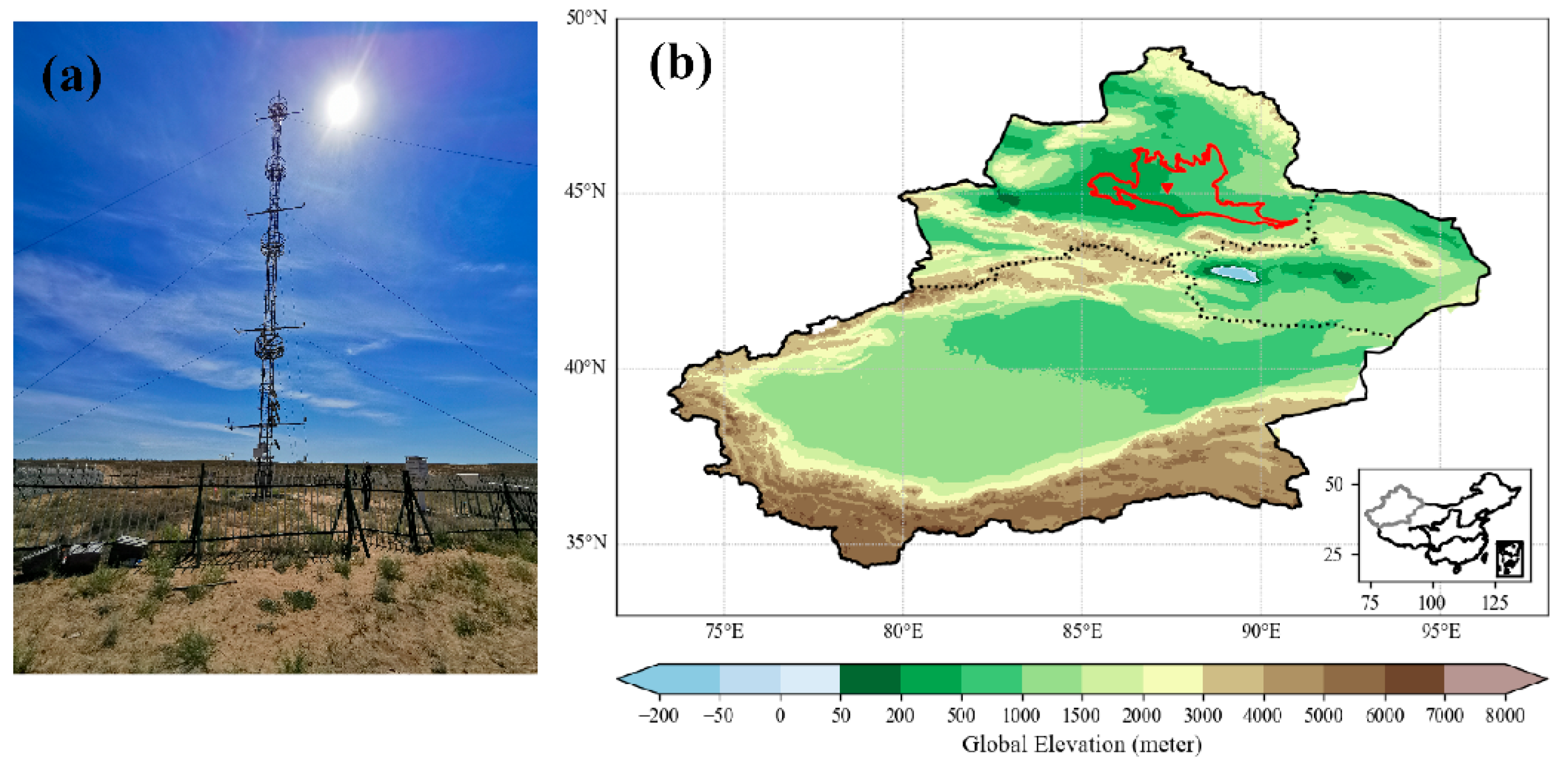
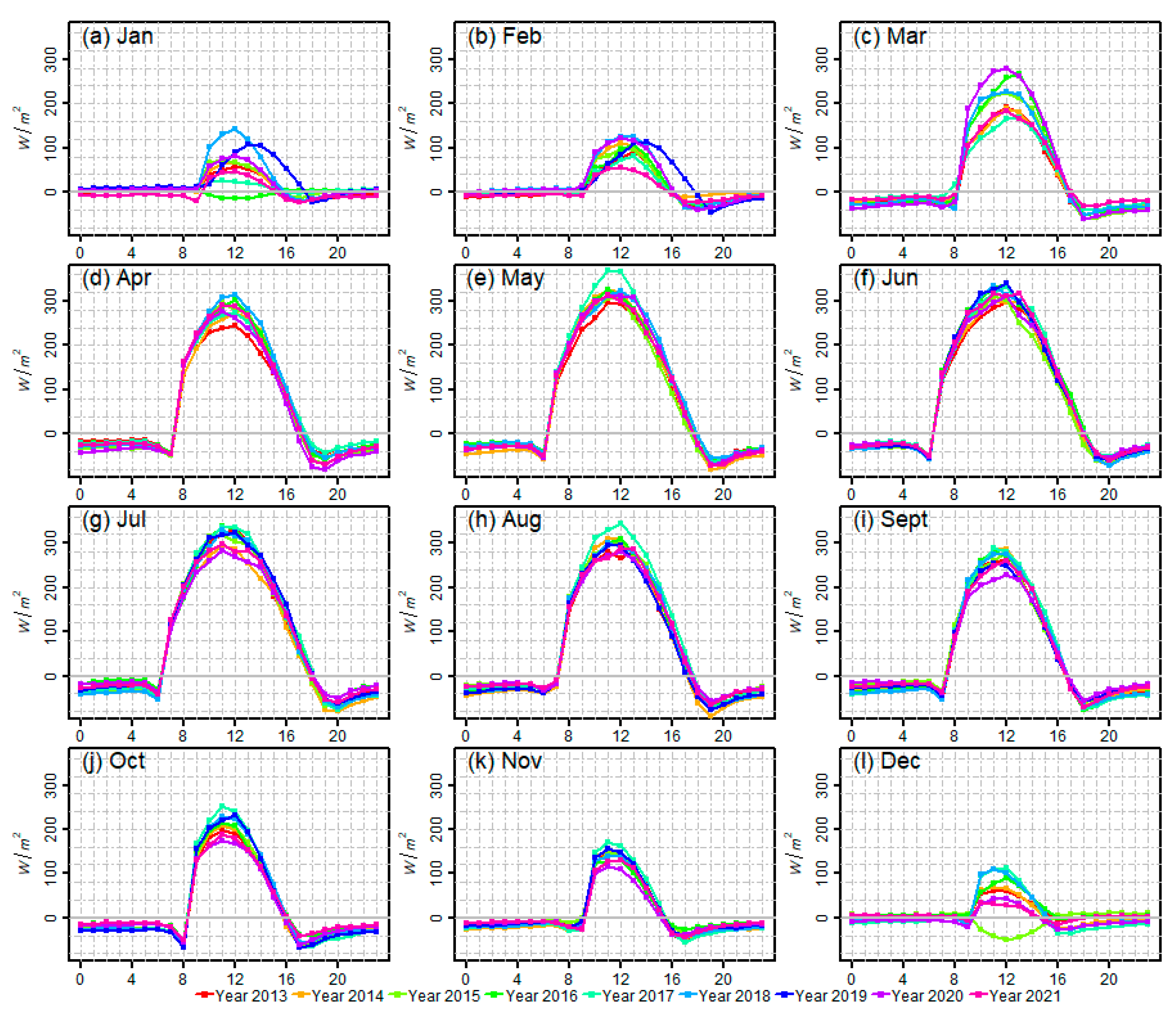
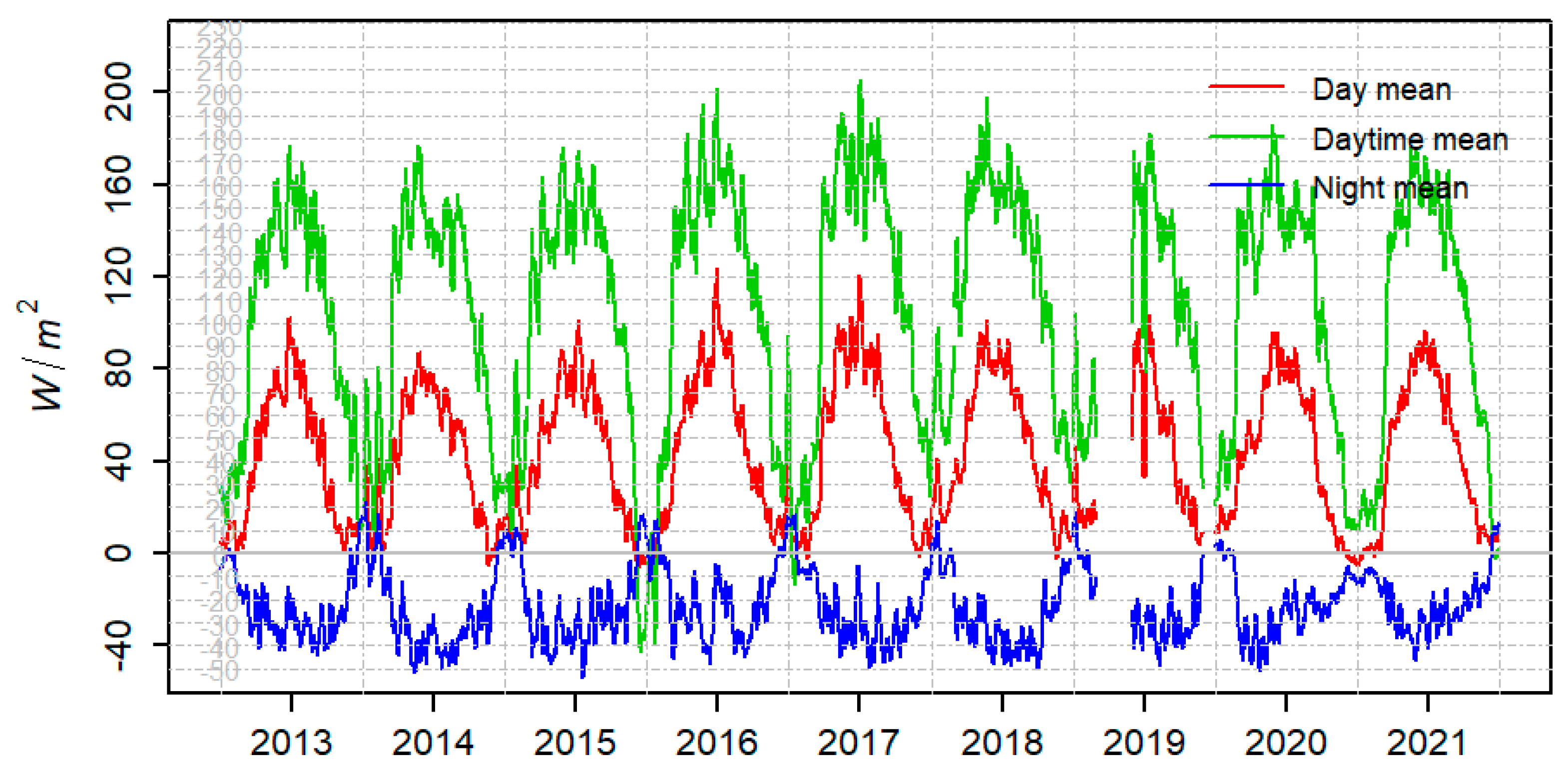


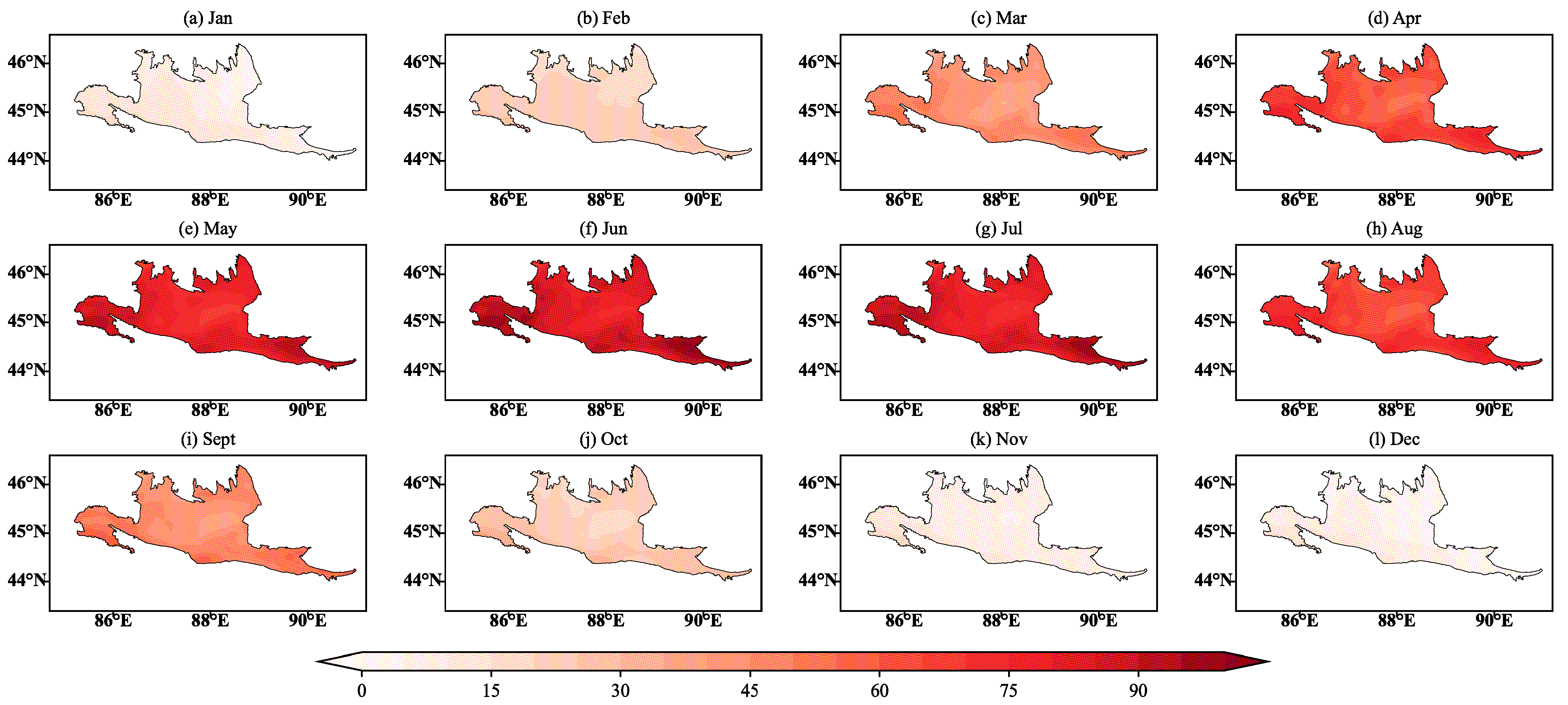
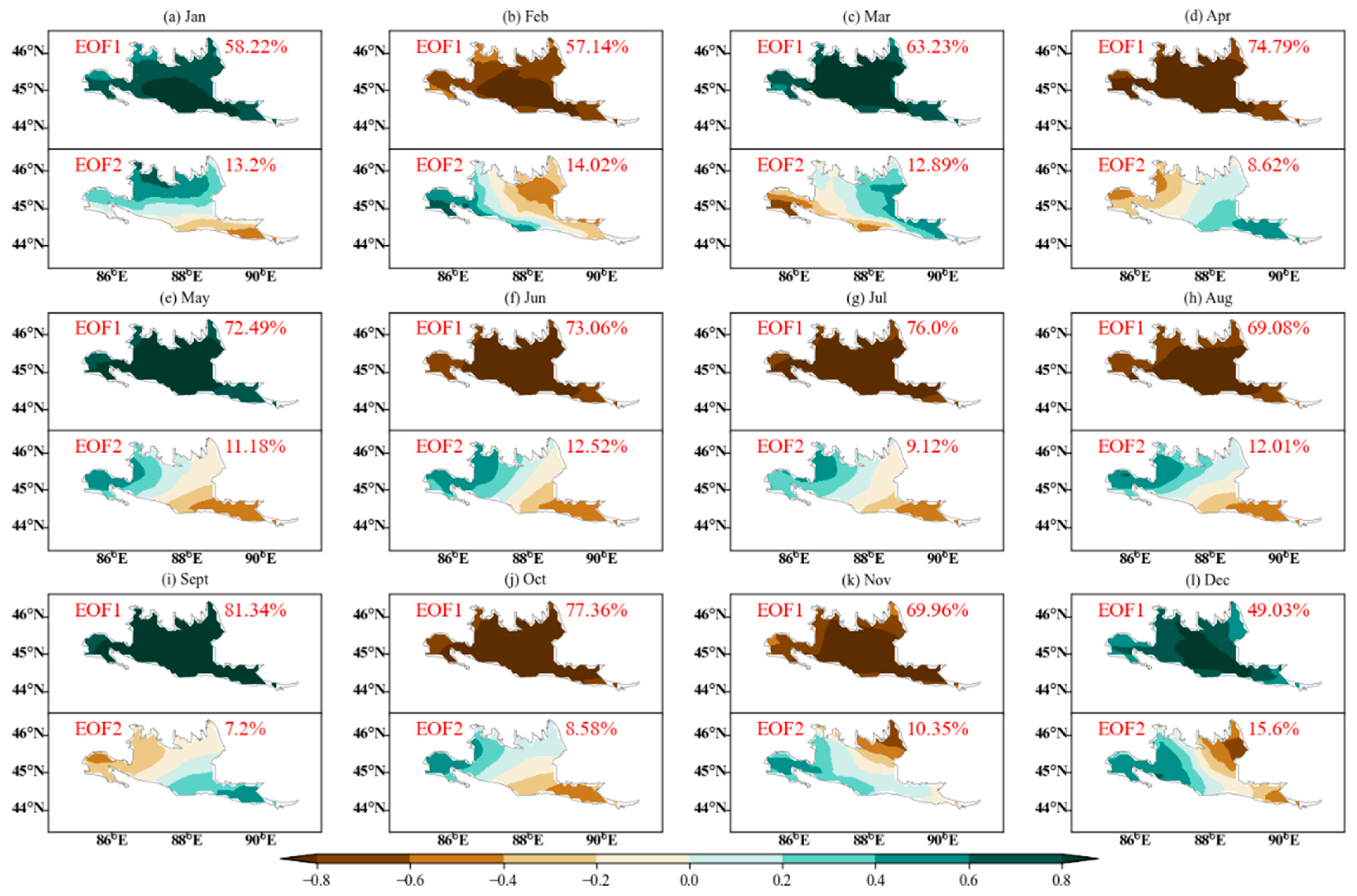
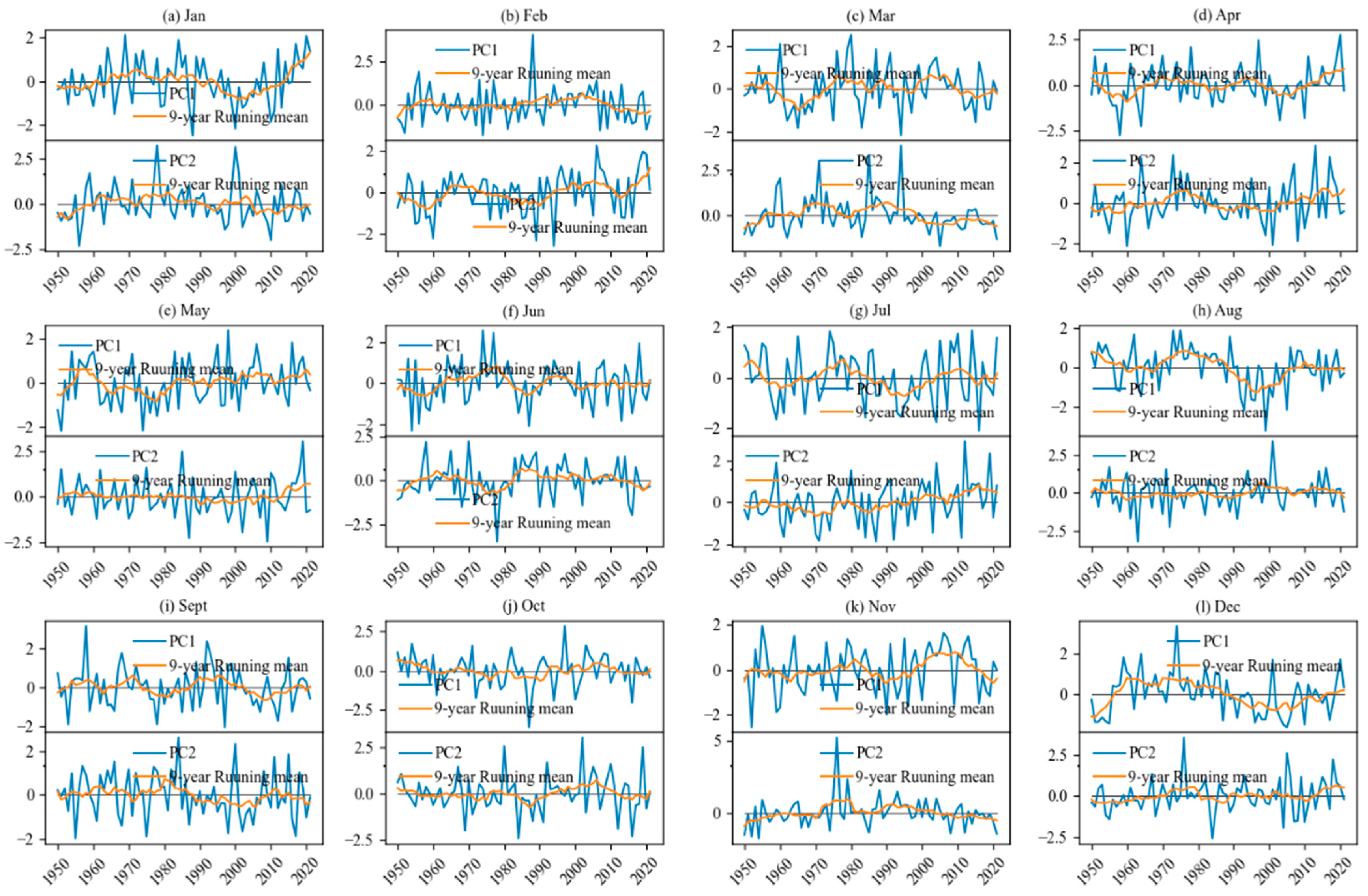

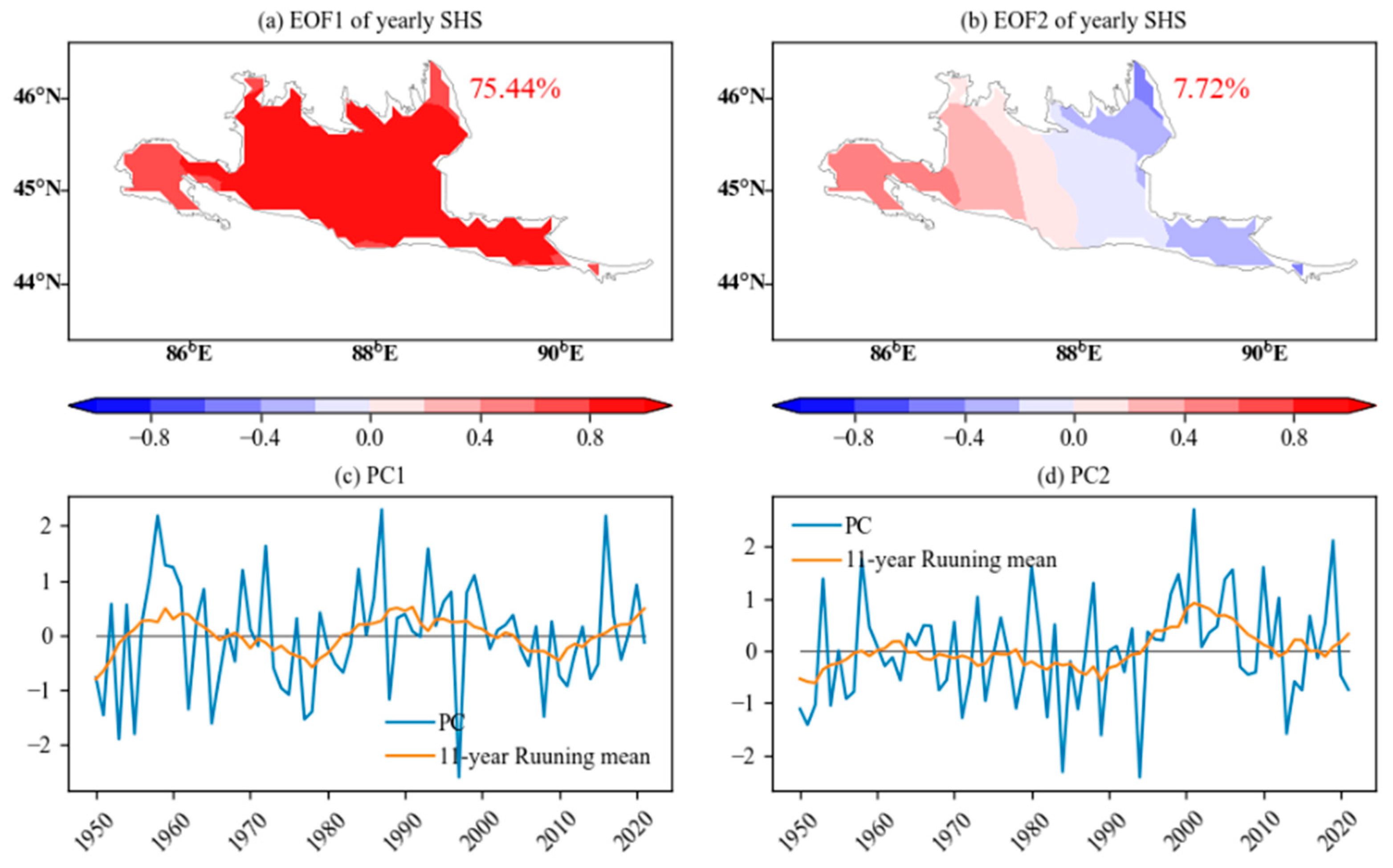
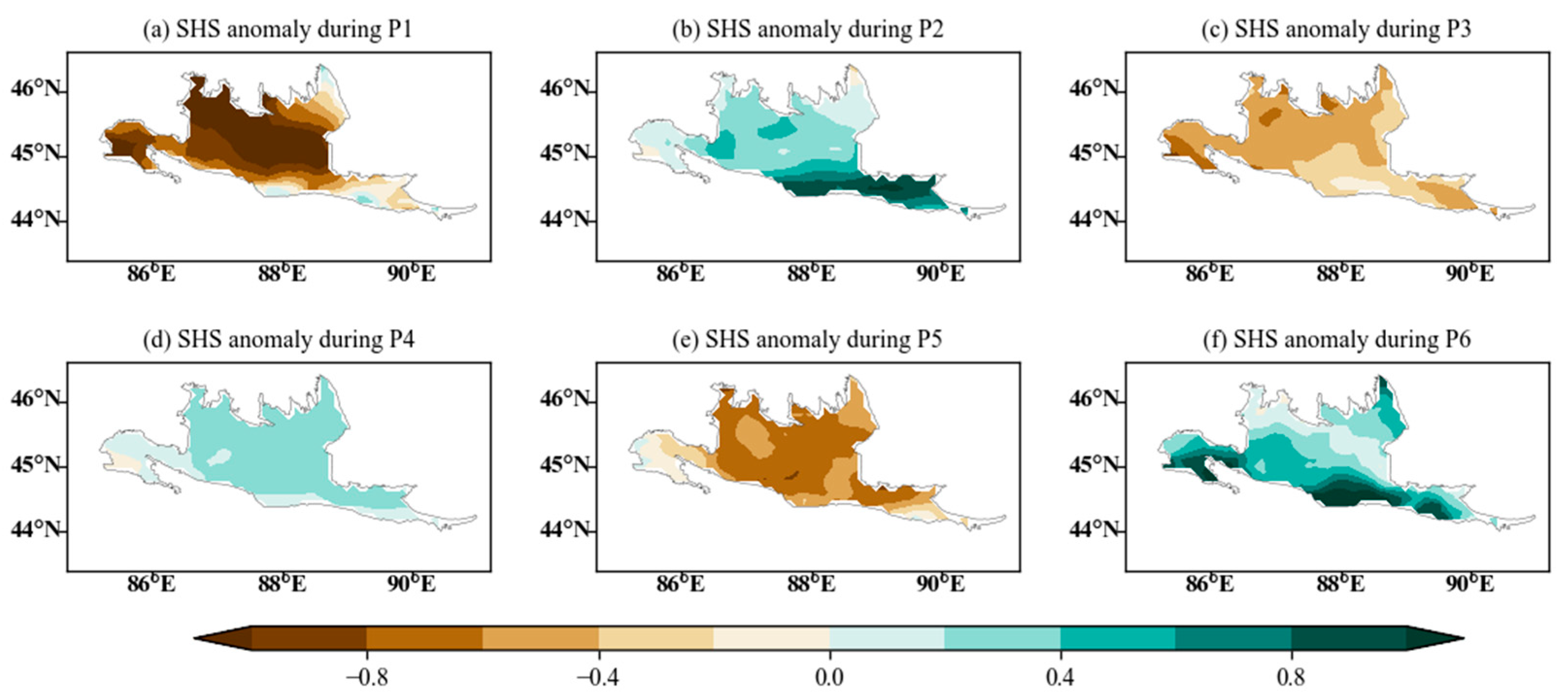
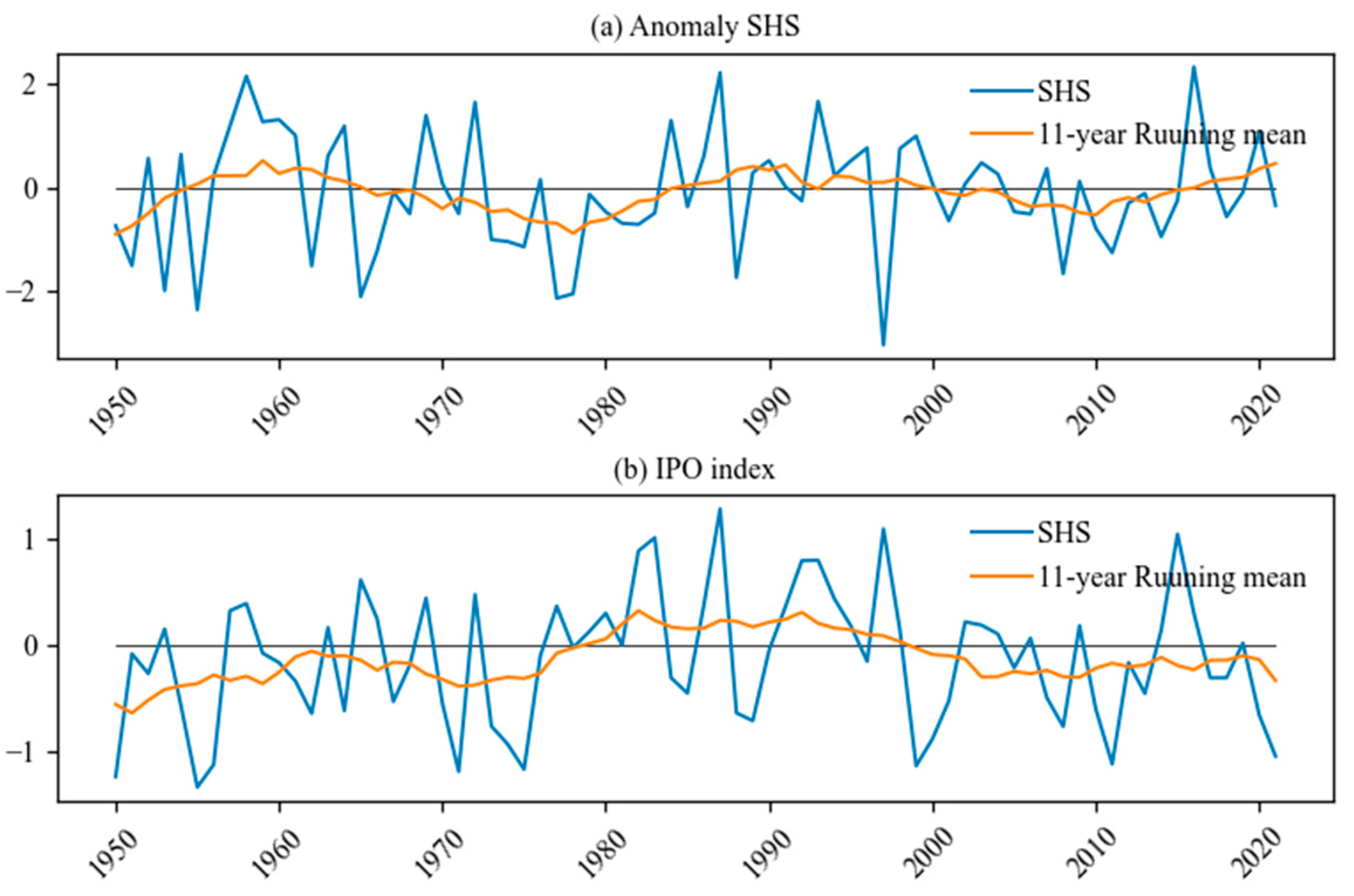
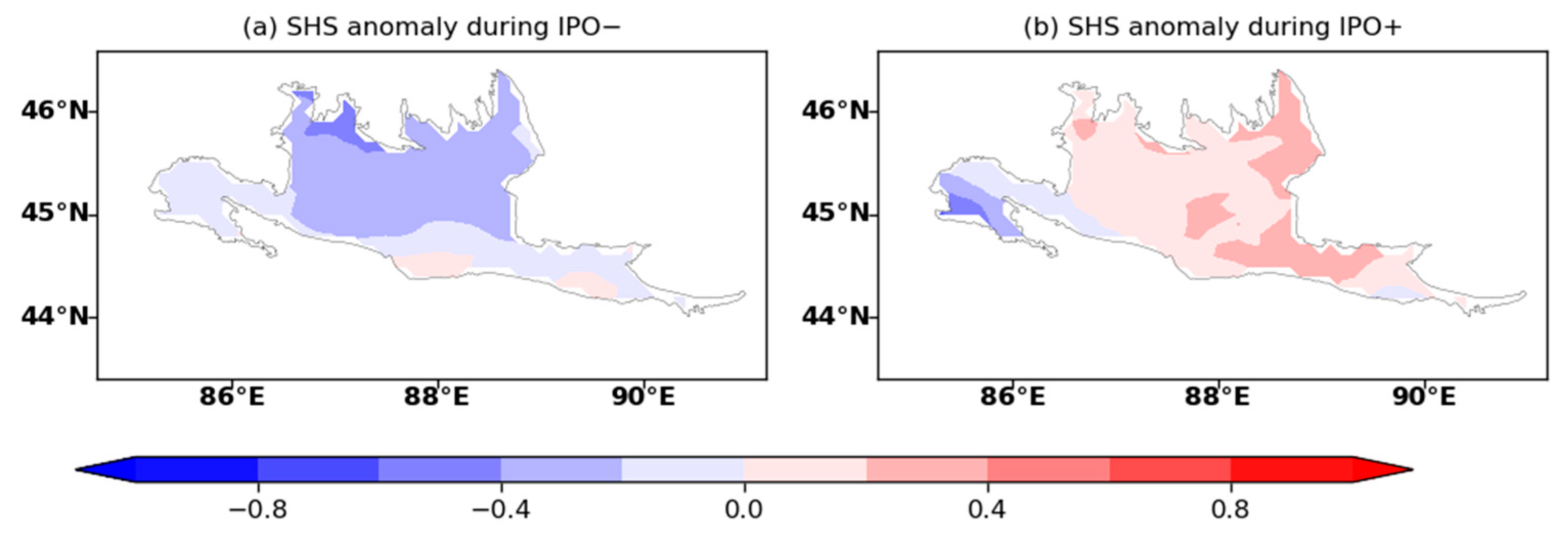
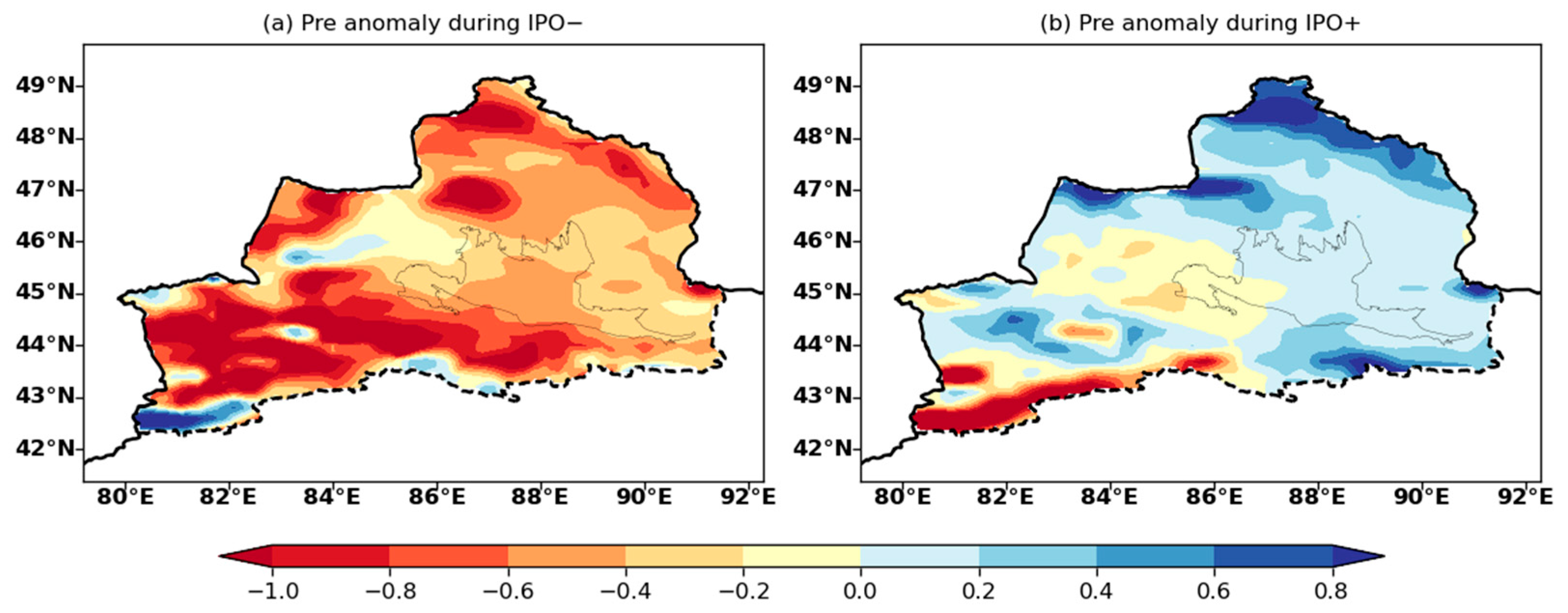
| RMSE | MAE | Interannual Variations | R2 | Corr. | |
|---|---|---|---|---|---|
| Observation | ERA5-Land | ||||
| 9.56 W/m2 | 8.32 W/m2 | 0.016 W/m2 | −0.013 W/m2 | 0.90 | 0.96 |
| Period | Period | SHS Anomaly |
|---|---|---|
| P1 | 1950–1954 | negative |
| P2 | 1955–1963 | positive |
| P3 | 1964–1982 | negative |
| P4 | 1983–2003 | positive |
| P5 | 2004–2015 | negative |
| P6 | 2016–2021 | positive |
Disclaimer/Publisher’s Note: The statements, opinions and data contained in all publications are solely those of the individual author(s) and contributor(s) and not of MDPI and/or the editor(s). MDPI and/or the editor(s) disclaim responsibility for any injury to people or property resulting from any ideas, methods, instructions or products referred to in the content. |
© 2023 by the authors. Licensee MDPI, Basel, Switzerland. This article is an open access article distributed under the terms and conditions of the Creative Commons Attribution (CC BY) license (https://creativecommons.org/licenses/by/4.0/).
Share and Cite
Aihaiti, A.; Wang, Y.; Mamtimin, A.; Liu, J.; Gao, J.; Song, M.; Wen, C.; Ju, C.; Yang, F.; Huo, W. Temporal and Spatial Surface Heat Source Variation in the Gurbantunggut Desert from 1950 to 2021. Remote Sens. 2023, 15, 5731. https://doi.org/10.3390/rs15245731
Aihaiti A, Wang Y, Mamtimin A, Liu J, Gao J, Song M, Wen C, Ju C, Yang F, Huo W. Temporal and Spatial Surface Heat Source Variation in the Gurbantunggut Desert from 1950 to 2021. Remote Sensing. 2023; 15(24):5731. https://doi.org/10.3390/rs15245731
Chicago/Turabian StyleAihaiti, Ailiyaer, Yu Wang, Ali Mamtimin, Junjian Liu, Jiacheng Gao, Meiqi Song, Cong Wen, Chenxiang Ju, Fan Yang, and Wen Huo. 2023. "Temporal and Spatial Surface Heat Source Variation in the Gurbantunggut Desert from 1950 to 2021" Remote Sensing 15, no. 24: 5731. https://doi.org/10.3390/rs15245731
APA StyleAihaiti, A., Wang, Y., Mamtimin, A., Liu, J., Gao, J., Song, M., Wen, C., Ju, C., Yang, F., & Huo, W. (2023). Temporal and Spatial Surface Heat Source Variation in the Gurbantunggut Desert from 1950 to 2021. Remote Sensing, 15(24), 5731. https://doi.org/10.3390/rs15245731







